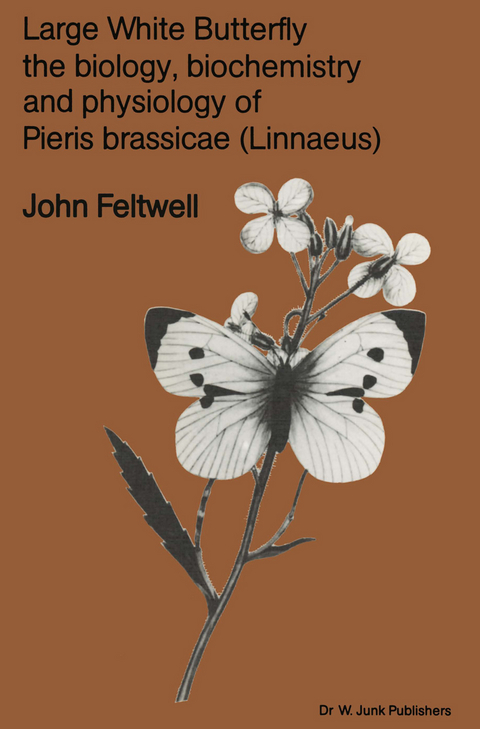
Large White Butterfly
Kluwer Academic Publishers (Verlag)
978-90-6193-128-7 (ISBN)
- Titel z.Zt. nicht lieferbar
- Versandkostenfrei innerhalb Deutschlands
- Auch auf Rechnung
- Verfügbarkeit in der Filiale vor Ort prüfen
- Artikel merken
The literature is still one of our biggest frustrations to-day. There is, in one sense, too much of it, and in another not enough - for there are insufficient and inadequate published guidelines through this jungle. Last year two excellent books for students of ecological chemistry were published, one in France and one in England. The concordance of the references was a mere overall 3% rising to 7% in the chapters on pheromones. Even in the computer age, the channel remains a formidable barrier to the rapid exchange of biological information. At the present time we are in urgent need of compilations similar to John Feltwell's "The Large White Butterfly"; since the literature has become virtually unmanageable. This insect is now a demonstration object in the sixth form schoolroom; an experimental "rabbit" in the University laboratory; a test animal in virus and bacterial research projects; a tool for the study of flight mechanisms, migration, plant biochemistry, hormones, genetics, allergies, pigments, mimicry, etc. , etc. John Feltwell has, by this massive compilation, rendered us a great service - in fact he has given us a present of 4,000 hours of library time spent in 50 different libraries in seven countries. In the process he has collected 8000 references to the Large White. Of these, 4000 have been selected, and we are given a brief indication of their contents.
1. Nomenclature.- Section A. Classification of Pieris brassicae.- Section B. Infrasubspecific variation and nomenclature.- References cited.- Further references.- 2. Distribution.- - Introduction.- - World range (Europe, Middle East, North Africa, Indian subcontinent, U.S.S.R., Far East, Australia and New Zealand, South America).- References cited.- Further references.- 3. Life history.- - Original descriptions.- - Life cycle.- - Eclosion.- - Courtship.- - Copulation.- - Roosting site.- - Voltinism.- - Abundance.- - Natural checks of populations.- - Intraspecific relationships.- References cited.- Further references.- 4. Foodplants.- - Introduction.- - Principal foodplants.- - Unusual foodplants.- - Acceptability.- References cited.- Further references.- 5. Breeding.- - Introduction.- - Breeding.- - Synthetic diets.- - Current research on P. brassicae.- References cited.- 6. Development.- Section A. Imaginal discs.- Section B. Larval development.- References cited.- Further references.- 7. Morphology and Anatomy.- General introduction.- Section A. Morphology.- Section B. Anatomy.- References cited.- 8. Physiology.- - Colouration of the larva and pupa.- - Diapause.- - Excretion.- - Respiration.- References cited.- Further references.- 9. Hormones.- - Early work.- - Introduction.- - Sites of secretion.- References cited.- 10. Biochemistry.- - Introduction.- - Carbohydrates.- - Lipids.- - Proteins.- - Amino acids.- - Enzymes and coenzymes.- - Vitamins.- - Pigments.- - Nucleotides.- - Mustard oil glycosides.- - Biochemistry of silk.- - Biochemistry of pupal exuviae.- - Radionuclides used on P. brassicae.- - Inorganic ions.- - Sexual similarities and differences.- References cited.- Further references.- 11. Migration.- - Introduction.- - Examples of migration.- - Mark and recapture.- References cited.- Further references.- 12. Senses.- - Introduction.- - Visual senses.- - Olfactory senses.- - Tactile senses.- - Auditory sense.- - Barometric sense.- - Ultra-violet reflectance.- - Thermoregulation.- - Defense mechanisms.- - Chemoreception.- References cited.- Further references.- 13. Economic importance.- - Introduction.- - Depredations by country.- - Estimate of world damage caused by P. brassicae.- References cited.- Further references.- 14. Parasitic control.- Section A. General information.- Section B. Biology of some effective parasites.- References cited.- Further references.- 15. Pathogenic control.- General introduction.- Section A. Bacterial control.- Section B. Virus control.- Section C. Fungal control.- Section D. Protozoan control.- References cited.- Further references.- 16. Predators.- - Introduction.- - Bird predators.- - Hymenopterous predators and scavengers.- - Hemipterous predators.- - Coleopterous predators.- - Other insect predators.- - Vertebrate and other miscellaneous predators and scavengers.- References cited.- 17. Chemical control.- - Introduction.- Section A. Control pre-1945.- Section B. Control post-1945 in the field.- Section C. P. brassicae as laboratory insect for insecticide use.- Section D. Current chemical control of P. brassicae infestations.- References cited.- Further references.- 18. Integrated control.- References cited.- Botanical specific name index.- Zoological specific name index.
| Erscheint lt. Verlag | 30.11.1981 |
|---|---|
| Reihe/Serie | Series Entomologica ; 18 |
| Zusatzinfo | 564 p. |
| Verlagsort | Dordrecht |
| Sprache | englisch |
| Themenwelt | Naturwissenschaften ► Biologie ► Evolution |
| Naturwissenschaften ► Biologie ► Zoologie | |
| ISBN-10 | 90-6193-128-2 / 9061931282 |
| ISBN-13 | 978-90-6193-128-7 / 9789061931287 |
| Zustand | Neuware |
| Haben Sie eine Frage zum Produkt? |
aus dem Bereich


